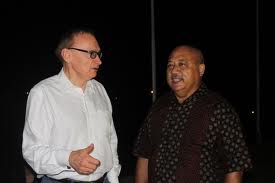Nautilus Peace and Security Weekly Report—Contributor’s blog entry for Austral Peace and Security.
Washington’s Pacific pivot is essentially a matter of the Obama administration drawing a line under the distractions of the Bush-era disasters of Iraq and Afghanistan, and re-focusing strategic planning on the rise of Chinese economic, political and military power. Rather than the crudities of the opening to India that Condoleeza Rice initiated as a geo-strategic “balance” against China in 2005, the Obama administration is pursuing a complex approach to China made up of both a search for dialogue on key issues such as climate change and the global economy, and at the same time regional military and political restructuring that strengthens old hub and spokes bilateral alliances with Japan, Korea and Australia, increases the military capacities of those allies, and seeks to draw in new regional strategic partners such as Indonesia and Singapore. Containment it may not yet be, but it here can be little doubt the objective is to hedge very strongly against expansion of Chinese influence, while continuing dialogue on the global rules of the road.
Yet the hinge of the pivot strategy is the domestic foundations of alliance amongst America’s three main allies in the Pacific, Japan, South Korea and Australia – all of which are characterised by a volatile disposition to anxiety. While Japan and Korea can point to serious security issues in their environment, the Australian case is characterised by an endemic propensity to alliance anxiety even in the virtually complete absence of serious relevant threat. To take what may appear to those outside Australia as a bizarre official example, while the Obama administration was working through the implications of the president’s Prague speech on the United States’ goal of a nuclear-free world, the 2009 Australian Defence White Paper, greatly expanded official discussion of Australian reliance on United States extended nuclear deterrence, citing the “remote possibilities” of nuclear threats to Australia from Iran and North Korea.
In the past, and again today, Australian alliance anxiety has manifested itself in seeking to demonstrate loyalty and strengthen US commitment not only by responding to US requests for participation in wars outside the region, but characteristically by offering support and military participation before being asked. The large scale expansion of US marine, air force and navy access to Australia facilities that has been underway for several years was accelerated on the occasion of President Obama’s Australian visit in November 2011 with announcements of deployments of US marines and USAF bombers and fighters to Darwin and other facilities. While some analysts concentrated on a theme of US arm-twisting of a reluctant Labor government, PACOM CinC Admiral Robert Willard let the cat out of the bag, saying the Australian side had offered access first:
Nautilus Peace and Security Weekly Report
"[...]While challenging Australians to think more deeply outside the settled ways of blind acceptance of all aspects of the American alliance, and repudiating current incoherent Australian defence planning (such as converting the bulk of the army into a regionally and indeed globally deployable niche amphibious force), White’s own analysis favours a realist approach to regional uncertainties emphasizing considerable expansion of defence force capacities for the defence of Australia in a region to be rendered inevitably turbulent by the continued rise of China. "
Last week White’s case was substantiated by a headline in a leading national
newspaper proclaiming “Defence cuts a ‘threat’ to US alliance.”
In fact, the Rudd-Gillard Labor governments have been even more
demonstrative in their support of the United States in Afghanistan and
other security concerns than the former conservative Prime Minister,
John Howard, dubbed “the Man of Steel” by George W. Bush.
While challenging Australians to think more deeply outside the settled ways of blind acceptance of all aspects of the American alliance, and repudiating current incoherent Australian defence planning (such as converting the bulk of the army into a regionally and indeed globally deployable niche amphibious force), White’s own analysis favours a realist approach to regional uncertainties emphasizing considerable expansion of defence force capacities for the defence of Australia in a region to be rendered inevitably turbulent by the continued rise of China. True to his own interpretation of the state of Australian security thinking, White’s admonitions are in turn under attack as an unthinkingly pessimistic interpretation of power-transition theory – but mainly by political figures now far from the centres of power in Australia, such as former hardline Liberal Party Prime Minister, Malcolm Fraser, now regarded by both sides of politics as a “mad leftie.”
In reality, Australians, living in a small country on the periphery of global power, face an extraordinarily complex set of cultural and intellectual tasks in addressing security threats, genuine and fantasized. The deep structure of Australian political culture involves essentially racialist cultural baggage of the country’s origins in genocide of its indigenous peoples as a settler colonial outpost of mother country Britain in “distant” Asia. This requires rebuilding on twin foundations of internal reconciliation with indigenous Australians and external integration with Asia and the South Pacific. Clearly both issues inflect the current question of “the rise of China” – with the United States having replaced Britain, and “the rise of China” implying much more than just a strategic re-arrangement. Hence the difficulties, silences, and contradictions of the current Australian debates.
The immediate, but clearly difficult first task is to complete the disengagement from the psycho-cultural detritus of the Cold War. In part this is a matter of placing the verities of the ANZUS alliance in a rational national interest perspective. But it is also a matter of unpicking the deep cultural structures of the nuclear aspects of the Cold War in a way that an even smaller but more courageous country New Zealand did in the 1980s. The Lange government of New Zealand did not want to leave the ANZUS alliance: it just did not want to be defended by US nuclear weapons. In the future, if the path to a nuclear-free world is to be more than a chimerical PR phrase, some if not all US allies will have to follow New Zealand on the road to a nuclear free alliance posture, escaping the trap for both sides of the alliance of adherence to extended nuclear deterrence in the absence of a serious nuclear threat that cannot be addressed with conventional responses.
The global transformation of its military forces that the US has embarked on with its Pacific pivot strategy inevitably articulates not only with a complex, contested and highly uncertain global and regional strategic environment, but also with complex and uncertain national domestic environments, which have their own urgent requirements for strategic renewal.
—Richard Tanter, NAPSNet Contributor
The Nautilus Peace and Security Weekly Report presents articles and full length reports each week in six categories: Austral security, nuclear deterrence, energy security, climate change adaptation, the DPRK, and governance and civil society. Our team of contributors carefully select items that highlight the links between these themes and the three regions in which our offices are found—North America, Northeast Asia, and the Austral-Asia region. Each week, one of our authors also provides a short blog that explores these inter-relationships.
Further News:
China a better Pacific friend than US: Samoan PM
Times of India video U.S Will Deploy 60% of Navy Fleet To Asia- Pacific region.
U.S Defence Secretary Leon Panetta's entire policy speech at the International Institute of Strategic Studies (IISS) Shangri-La Dialogue (video posted below)
Washington’s Pacific pivot is essentially a matter of the Obama administration drawing a line under the distractions of the Bush-era disasters of Iraq and Afghanistan, and re-focusing strategic planning on the rise of Chinese economic, political and military power. Rather than the crudities of the opening to India that Condoleeza Rice initiated as a geo-strategic “balance” against China in 2005, the Obama administration is pursuing a complex approach to China made up of both a search for dialogue on key issues such as climate change and the global economy, and at the same time regional military and political restructuring that strengthens old hub and spokes bilateral alliances with Japan, Korea and Australia, increases the military capacities of those allies, and seeks to draw in new regional strategic partners such as Indonesia and Singapore. Containment it may not yet be, but it here can be little doubt the objective is to hedge very strongly against expansion of Chinese influence, while continuing dialogue on the global rules of the road.
Yet the hinge of the pivot strategy is the domestic foundations of alliance amongst America’s three main allies in the Pacific, Japan, South Korea and Australia – all of which are characterised by a volatile disposition to anxiety. While Japan and Korea can point to serious security issues in their environment, the Australian case is characterised by an endemic propensity to alliance anxiety even in the virtually complete absence of serious relevant threat. To take what may appear to those outside Australia as a bizarre official example, while the Obama administration was working through the implications of the president’s Prague speech on the United States’ goal of a nuclear-free world, the 2009 Australian Defence White Paper, greatly expanded official discussion of Australian reliance on United States extended nuclear deterrence, citing the “remote possibilities” of nuclear threats to Australia from Iran and North Korea.
In the past, and again today, Australian alliance anxiety has manifested itself in seeking to demonstrate loyalty and strengthen US commitment not only by responding to US requests for participation in wars outside the region, but characteristically by offering support and military participation before being asked. The large scale expansion of US marine, air force and navy access to Australia facilities that has been underway for several years was accelerated on the occasion of President Obama’s Australian visit in November 2011 with announcements of deployments of US marines and USAF bombers and fighters to Darwin and other facilities. While some analysts concentrated on a theme of US arm-twisting of a reluctant Labor government, PACOM CinC Admiral Robert Willard let the cat out of the bag, saying the Australian side had offered access first:
“Australia made overtures to the United States to increase our engagement with the armed forces of Australia and our utility of the training facilities – ranges, and so forth – that are there.”In reality, the United States has no firmer ally in the Pacific than Australia. So deeply is the ANZUS alliance (albeit absent nuclear-free New Zealand) embedded into Australian political culture that former Deputy Secretary of Defence Hugh White remarks that in debate about how to respond to the rise of China (Australia’s largest trading partner) very few people on either side of mainstream Australian politics or in the broader security practitioner community seem able to even conceptualise – let alone seriously consider – strategic options outside the current version of the ANZUS alliance. Australian identity appears to have become deeply fused with the US alliance, sixty years after it was established, and in a very different strategic and economic environment.
Nautilus Peace and Security Weekly Report
"[...]While challenging Australians to think more deeply outside the settled ways of blind acceptance of all aspects of the American alliance, and repudiating current incoherent Australian defence planning (such as converting the bulk of the army into a regionally and indeed globally deployable niche amphibious force), White’s own analysis favours a realist approach to regional uncertainties emphasizing considerable expansion of defence force capacities for the defence of Australia in a region to be rendered inevitably turbulent by the continued rise of China. "
While challenging Australians to think more deeply outside the settled ways of blind acceptance of all aspects of the American alliance, and repudiating current incoherent Australian defence planning (such as converting the bulk of the army into a regionally and indeed globally deployable niche amphibious force), White’s own analysis favours a realist approach to regional uncertainties emphasizing considerable expansion of defence force capacities for the defence of Australia in a region to be rendered inevitably turbulent by the continued rise of China. True to his own interpretation of the state of Australian security thinking, White’s admonitions are in turn under attack as an unthinkingly pessimistic interpretation of power-transition theory – but mainly by political figures now far from the centres of power in Australia, such as former hardline Liberal Party Prime Minister, Malcolm Fraser, now regarded by both sides of politics as a “mad leftie.”
In reality, Australians, living in a small country on the periphery of global power, face an extraordinarily complex set of cultural and intellectual tasks in addressing security threats, genuine and fantasized. The deep structure of Australian political culture involves essentially racialist cultural baggage of the country’s origins in genocide of its indigenous peoples as a settler colonial outpost of mother country Britain in “distant” Asia. This requires rebuilding on twin foundations of internal reconciliation with indigenous Australians and external integration with Asia and the South Pacific. Clearly both issues inflect the current question of “the rise of China” – with the United States having replaced Britain, and “the rise of China” implying much more than just a strategic re-arrangement. Hence the difficulties, silences, and contradictions of the current Australian debates.
The immediate, but clearly difficult first task is to complete the disengagement from the psycho-cultural detritus of the Cold War. In part this is a matter of placing the verities of the ANZUS alliance in a rational national interest perspective. But it is also a matter of unpicking the deep cultural structures of the nuclear aspects of the Cold War in a way that an even smaller but more courageous country New Zealand did in the 1980s. The Lange government of New Zealand did not want to leave the ANZUS alliance: it just did not want to be defended by US nuclear weapons. In the future, if the path to a nuclear-free world is to be more than a chimerical PR phrase, some if not all US allies will have to follow New Zealand on the road to a nuclear free alliance posture, escaping the trap for both sides of the alliance of adherence to extended nuclear deterrence in the absence of a serious nuclear threat that cannot be addressed with conventional responses.
The global transformation of its military forces that the US has embarked on with its Pacific pivot strategy inevitably articulates not only with a complex, contested and highly uncertain global and regional strategic environment, but also with complex and uncertain national domestic environments, which have their own urgent requirements for strategic renewal.
—Richard Tanter, NAPSNet Contributor
The Nautilus Peace and Security Weekly Report presents articles and full length reports each week in six categories: Austral security, nuclear deterrence, energy security, climate change adaptation, the DPRK, and governance and civil society. Our team of contributors carefully select items that highlight the links between these themes and the three regions in which our offices are found—North America, Northeast Asia, and the Austral-Asia region. Each week, one of our authors also provides a short blog that explores these inter-relationships.
Further News:
China a better Pacific friend than US: Samoan PM
Times of India video U.S Will Deploy 60% of Navy Fleet To Asia- Pacific region.
U.S Defence Secretary Leon Panetta's entire policy speech at the International Institute of Strategic Studies (IISS) Shangri-La Dialogue (video posted below)
Club Em Designs











